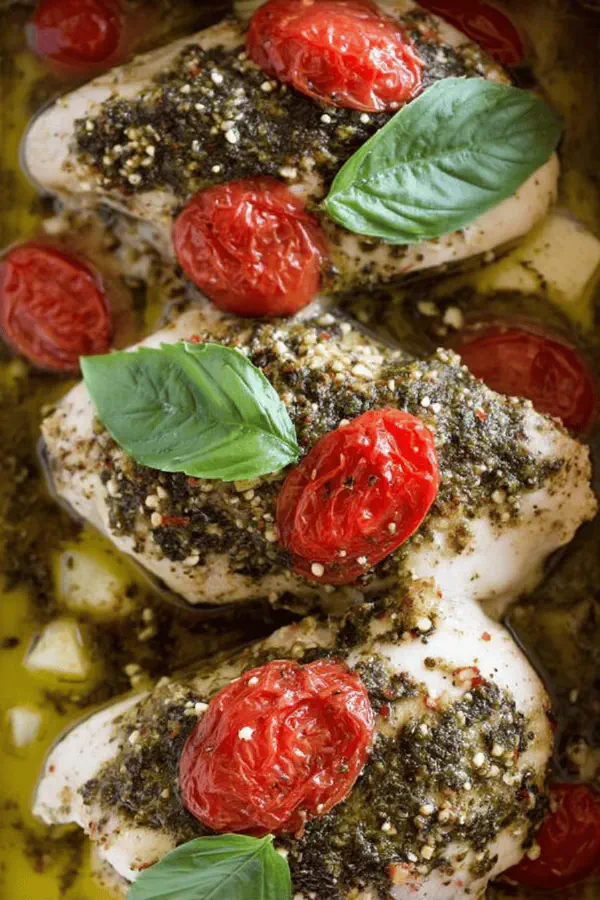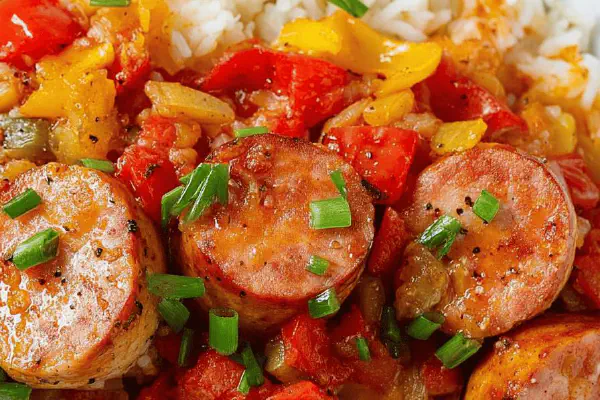Featured Recipe
Pesto Stuffed Chicken Bake

By Kate
"
Chicken breasts sliced and stuffed with homemade or store-bought pesto and cheese, baked surrounded by cherry tomatoes tossed in lemon juice and olive oil. Simple techniques ensure juicy, flavorful chicken finished to an internal temp of 165°F. Mozzarella or provolone can work. Watch for tomato skins blistering and chicken juices running clear. Practical substitutions included: swap chicken for turkey cutlets, basil pesto swapped for sun-dried tomato pesto for earthier notes, and lemon juice replaced with white wine vinegar if needed. A touch of smoked paprika adds twist and depth.
"
Prep:
25 min
Cook:
50 min
Total:
Serves:
3 servings
chicken
bake
pesto
dinner
family-friendly
Introduction
Start preheating. Pesto and cheese ready, you just need to focus on technique. Chicken needs precision; not overcut, not overstuffed—if you slice through, stuffing leaks. Tucking basil, cheese, moisture inside pockets protects meat from drying during long bake. Tomatoes roast alongside, releasing bursts of acidic sweetness, juices mingling in the pan. Lemon juice drizzles add necessary brightness and balance against the richness. Oil coats the chicken, makes for golden spots where it touches pan or air. Cover loosely at start prevents drying but lets steam lift flavors inside. Knowing when chicken’s done? Not always clocks but juices running clear, slight firmness but still a bit springy. Resting, important—carryover heat finishes the job while juices settle. The cheese melting, the tomatoes bubbling, the smell of lemon and basil hitting the nose—those signs tell you you’re on track.
Ingredients
About the ingredients
Substitution flexibility critical. If no fresh basil or pesto on hand, sun-dried tomato pesto shakes things up by giving earthier, intensified flavor. Mozzarella can be swapped for provolone, fontina, or even a bit of grated parmesan; just don’t use watery, fresh mozzarella or risk soggy filling. Lemon juice is bright but can be replaced with white wine vinegar; same acidity but less sharpness. When picking tomatoes, cherry or grape types are best for roasting; they hold up well and develop sweet acidity. Chicken breasts tend to dry if overbaked. Thicker ones might need 5-10 minutes extra; thinner breasts hit temp faster; use instant read thermometer or check doneness by sight and tactile cues. Toothpicks, essential to avoid messy stuffed thawing—that filling wants to slide out under heat. Be sure to rinse any meat or tools and dry meat surface before slicing; dry chicken browns better versus steamed sogginess. Non-stick spray preferred over oil for even coating and less mess.
Method
Technique Tips
Cutting chicken horizontally leaves an uneven thickness inside. That matters for stuffing but also for cooking evenness. Press open breast flat with palm if you want more manageable shape; doesn’t need to be paper thin but consistent thickness helps cheese melt evenly without overheating chicken surface. Stuffing too wet dilutes browning and makes chicken steam instead of roast. Use thick pesto or strain fresh pesto a bit. Toothpicks fix stuffed chicken closed but avoid excessive piercing that tears meat; 2-3 toothpicks minimum; if worried about slipping, a quick double wrap of kitchen twine works but toothpicks faster. Scatter tomatoes strategically, don’t pack them tight; allows juice release without steaming chicken. Lemon juice or vinegar should be fresh; older citrus loses brightness and turns bitter. Cover pan with foil loosely; tight seal or lid traps steam too much and ruins roasted texture. Cook 50 minutes then check; internal temperature 165°F is reliable but juices running clear—no pink—is practical if thermometer absent. Remove foil last 10 minutes for browning signals completed Maillard reactions; cheese will bubble and brown lightly. Rest chicken at least 5 minutes, tented loosely with foil, so juices redistribute—cutting immediately loses moisture, ends up dry and tough. Best served with greens or simple pasta to balance richness. The cooking sounds—crackling tomatoes, sizzling edges—play cues you’ll get with experience. Fail-safe trick: check one breast early, adjust time for the others accordingly.
Chef's Notes
- 💡 Slice chicken nicely — not all the way through. Leaving a hinge really helps stuffing stay in. If you cut too deep, everything leaks. Adjust baking time based on thickness; thin cooks fast, thick takes longer. Watch for temperature signs; juices should run clear. That’s when it's done.
- 💡 Pesto moisture can ruin browning. Use just enough; too much liquid and the chicken steams instead of roasting. Dry cherry tomatoes well. Moisture makes for steamy mess — aim for nice blistering and sweetness, not soggy. Use non-stick spray; oil makes a greasy mess.
- 💡 Consider swapping cheeses for different flavors. Provolone or fontina changes taste without compromising texture. Don't pick fresh mozzarella, too watery; go for thicker cheese. Similarly, white wine vinegar can take lemon juice place, it’s milder in flavor but still packs the acid punch needed.
- 💡 Strategize tomato placement around chicken; they need space to caramelize. If too crowded, chicken won’t roast properly. Monitor sound — listen for crackling or popping; it’s the tomatoes cooking through. Last ten minutes? Remove foil. Look for cheese browning and chicken sizzling, signals it's finishing.
- 💡 Resting chicken after baking matters a lot. It redistributes juices within; if you cut too soon, all the moisture runs out, leaving a dry bite. Use tongs to pull out toothpicks, serve forward. Great options? Pairing with steamed vegetables or pasta can soak up sauce.
Kitchen Wisdom
How do I know when my chicken is done?
Look for juices running clear, about 165°F internal temp. Thin cuts may cook faster. Use a thermometer if unsure. Don't just rely on time; each size differs.
What to do if my filling leaks out?
Avoid overstuffing. Secure well with toothpicks. If it happens, place stuffed side down in pan; helps keeps filling in. Adjust filling amount next time.
Can I freeze leftovers?
Yes, wrap tightly. It holds up nicely for up to three months. Thaw in fridge overnight. Go slow. Reheat gently; helps maintain texture without drying out.
What alternatives exist for basil pesto?
Sun-dried tomato pesto offers earthiness. Or try a homemade herb blend. Options like spinach or arugula mixed in work, but taste changes. Stick with dense sauces to avoid moisture issues.



